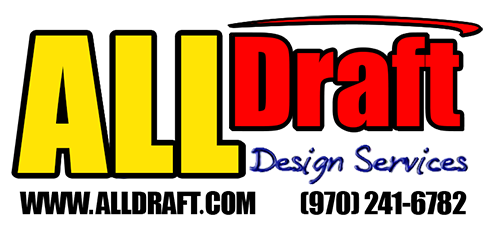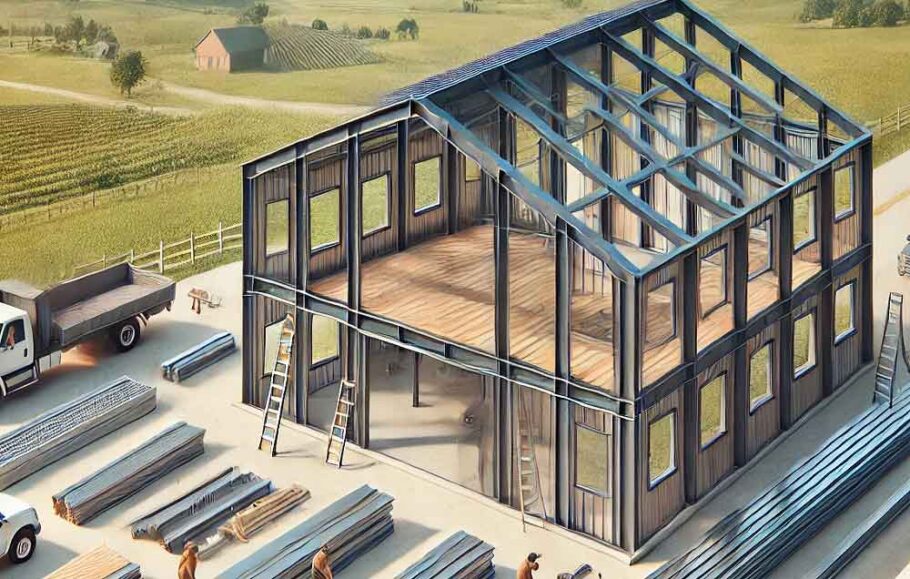When designing a barndominium, the structural engineer’s primary challenge is ensuring the building’s stability under lateral loads — the horizontal forces caused by wind, seismic activity, or even unbalanced snow on a sloped roof. While vertical loads (from gravity) are handled by columns, beams, and foundations, lateral stability requires a carefully engineered system that resists sideways motion and prevents collapse.
Two of the most common systems used in barndominiums to achieve this lateral stability are moment-resisting frames (moment frames) and shear walls. Both methods provide rigidity and strength, but they do so in fundamentally different ways — and each has its own advantages, limitations, and ideal applications.
This article breaks down the engineering logic behind both systems, compares their pros and cons, and explores how to decide which is right for your barndominium project.
Understanding Lateral Forces in Barndominiums
Before diving into structural systems, it’s important to understand what barndominiums are up against.
- Wind Loads
Wind can exert enormous pressure on the walls and roof of a barndominium, especially in open rural settings where barns often stand. The pressure doesn’t just push — it also tries to pull, creating uplift forces that can pry apart poorly braced structures.
- Seismic Loads
In earthquake zones, the ground moves laterally beneath the structure. The building’s inertia resists this motion, generating dynamic side-to-side forces that can cause sway, cracking, or collapse if not properly resisted.
- Unbalanced or Transient Loads
Snow drifting, partial occupancy, or large moving equipment in a shop area can produce lateral imbalance as well. Even these short-term forces must be accounted for.
To handle all this, engineers choose between systems that can absorb and transfer these loads safely to the foundation. That’s where moment frames and shear walls come into play.
Moment Frames: Strength Through Flexibility
A moment frame is a structural system where beams and columns are rigidly connected — not with simple pins or bolts that allow rotation, but with welded or reinforced joints that resist bending.
How They Work
When wind or seismic forces try to push the building sideways, the rigid beam-column joints create bending moments (hence the name “moment frame”) that counteract the motion. The frame deforms slightly but maintains its shape, transferring loads down into the foundation.
Moment frames are essentially a skeleton of steel or engineered wood that keeps the structure stable through flexural stiffness rather than wall rigidity.
Pros of Moment Frames
1. Design Flexibility and Open Floor Plans
Moment frames are ideal for open-concept barndominiums, where large interior spaces without walls are desired — such as a combined workshop and living area or an expansive great room.
Since moment frames rely on the frame itself rather than walls, they allow wide openings for doors, windows, or garage bays without compromising structural integrity.
2. Aesthetics and Architectural Freedom
Architects and designers love moment frames because they allow nearly unlimited layout freedom. Exterior cladding can be glass, corrugated metal, or even wood — the structural system doesn’t depend on shear walls that dictate solid surfaces.
This makes moment frames especially popular for modern barndominium designs featuring glass curtain walls or loft-style interiors.
3. Reusability and Adaptability
Moment frames can be modified more easily than shear walls. If a homeowner later decides to expand the living space or remove a partition, the structure remains stable as long as frame connections are properly engineered.
4. Ductile Behavior in Earthquakes
Moment frames perform well in seismic regions because of their ductility — they can bend and deform under load without sudden failure. This energy absorption characteristic prevents catastrophic collapse during earthquakes.
5. Reduced Weight
In metal barndominiums, moment frames are usually made of light-gauge steel or structural steel, making the system relatively lightweight compared to heavy concrete or masonry shear walls.
Cons of Moment Frames
1. High Fabrication and Welding Cost
Rigid beam-column connections require precise welding, bolting, and inspection. This level of craftsmanship adds cost and time to fabrication, especially in custom metal barndominiums.
2. Complex Engineering
Moment frame systems require detailed finite-element analysis and close collaboration between structural engineers and fabricators. Small errors in connection detailing can lead to poor performance under load.
3. Greater Deflection (Sway)
While moment frames resist collapse, they tend to sway more under load than shear wall systems. Excessive drift can crack finishes, cause door misalignment, or create occupant discomfort in tall structures.
4. Fireproofing and Corrosion Concerns
Since most barndominiums use exposed metal frames, the steel must be protected from both fire and corrosion. Special coatings or encasements may be required, adding to the cost.
5. Not Always Cost-Effective for Small Builds
For smaller barndominiums or those without large open spaces, the complexity and cost of moment frames often outweigh their benefits.
Shear Walls: Strength Through Rigidity
A shear wall is a structural wall designed to resist lateral forces by acting as a vertical cantilever beam. These walls are usually made of wood panels (OSB or plywood), steel sheets, reinforced concrete, or structural masonry, depending on the building’s design.
How They Work
When lateral loads act on the structure, shear walls transfer the force through their planar stiffness directly down to the foundation. The wall resists deformation through shear (internal sliding resistance between layers), hence the name.
In barndominiums, shear walls are often integrated into end walls, sidewalls, or interior partitions, where they double as load-bearing and stabilizing elements.
Pros of Shear Walls
1. Excellent Stiffness and Drift Control
Shear walls minimize sway, providing a rigid and stable structure. This makes them ideal for tall barndominiums, mezzanine levels, or those in high-wind zones.
2. Cost-Effective
Shear walls are often simpler and cheaper to construct than moment frames. A standard framed wall sheathed with structural panels can serve both as an enclosure and a lateral-force-resisting element.
3. Straightforward Construction
Framers and builders are familiar with shear wall systems. They can be built using conventional techniques without specialized steel fabrication or welding.
4. Excellent Performance in Wood-Frame Barndominiums
For wood or hybrid structures, shear walls are a natural fit. Using OSB or plywood sheathing, they provide both structural stability and a nailable surface for interior finishes.
5. Superior Wind Resistance
Rigid shear walls are particularly effective in resisting wind uplift and racking, making them common in hurricane-prone regions like the Gulf Coast.
Cons of Shear Walls
1. Reduced Design Flexibility
Shear walls require solid wall segments without large openings, which can restrict window placement, doors, or open interiors. This limitation is often a deal-breaker for barndominium owners seeking open layouts.
2. Added Weight and Material Use
Concrete or masonry shear walls add considerable dead load, requiring a stronger foundation. Even wood shear walls increase weight and affect load paths compared to lighter steel frames.
3. Potential for Asymmetric Rigidity
If shear walls are not symmetrically placed, the building can twist (torsion) under lateral load. Engineers must ensure balanced wall placement to prevent uneven movement.
4. Limited Future Modifications
Once built, shear walls cannot easily be altered or penetrated — cutting an opening for a new window or door can severely compromise structural integrity.
5. Less Effective for Large, Open Spans
In large shop areas or aircraft hangar-style barndominiums, shear walls are impractical because they require too many continuous solid walls.
Comparative Summary: Moment Frames vs. Shear Walls
| Feature | Moment Frames | Shear Walls |
| Structural Behavior | Flexible frame resisting bending moments | Rigid wall resisting shear forces |
| Best For | Open-plan barndominiums, large bays | Smaller or traditional layouts with solid walls |
| Cost | Higher due to complex connections | Lower; uses standard framing methods |
| Architectural Flexibility | Excellent | Limited |
| Seismic Performance | Ductile (absorbs energy) | Stiff (less drift but brittle) |
| Wind Resistance | Good | Excellent |
| Ease of Construction | Complex fabrication | Simple framing |
| Future Modifications | Easier | Difficult or impossible |
| Material Options | Steel, engineered wood | Wood, concrete, or steel panels |
Hybrid Systems: The Best of Both Worlds
In modern barndominium design, engineers often combine both systems to optimize performance and cost. For example:
- Shear walls on the shorter ends of the building for stiffness.
- Moment frames around garage doors or large window openings to preserve layout freedom.
- Roof diaphragm acting as a load distributor between frames and walls.
This hybrid approach leverages the rigidity of shear walls and the ductility of moment frames, creating a balanced lateral system ideal for most barndominiums.
Choosing the Right System for Your Barndominium
The decision comes down to several factors:
- Building Size and Use — Larger or multi-use structures often favor moment frames for openness.
- Climate and Seismic Zone — High wind = shear walls; earthquake zones = moment frames.
- Budget and Fabrication Resources — Shear walls are more economical; moment frames require specialized labor.
- Aesthetic Goals — If you want panoramic views or barn doors on every wall, moment frames provide freedom.
- Future Adaptability — For evolving spaces (workshops turned into homes), moment frames are easier to modify.
Conclusion
Lateral stability is one of the most critical yet often overlooked aspects of barndominium design. Whether you choose moment frames, shear walls, or a combination of both, the goal remains the same: ensuring the building stands firm against wind, seismic, and other lateral forces.
Moment frames deliver architectural freedom and seismic resilience, while shear walls provide simplicity, stiffness, and economy. In most modern barndominiums, a hybrid strategy—using each where it performs best—offers the strongest, safest, and most cost-effective result.
When planning your next barndominium, work with a licensed structural engineer who can analyze site-specific loads, soil conditions, and design goals to determine the optimal lateral stability system. Because in the world of barndominiums, beauty may be in the open space — but safety lies in the structure that keeps it standing.

